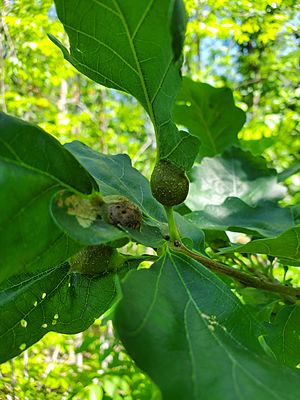Oak petiole gall wasp facts for kids
Quick facts for kids Oak petiole gall wasp |
|
|---|---|
 |
|
| Galls on bur oak | |
| Scientific classification | |
| Genus: |
Andricus
|
| Species: |
quercuspetiolicola
|
| Synonyms | |
|
|
The Andricus quercuspetiolicola, also known as the oak petiole gall wasp, is a tiny insect. It belongs to a group of wasps called gall wasps. These wasps are famous for making special growths, called galls, on plants. For this wasp, the galls grow on the leaves of oak trees. Inside these galls, the young wasps (larvae) live and eat. You can find these galls on the main vein or stem (petiole) of white oak leaves.
Contents
Where This Wasp Lives
This little wasp can be found across the eastern part of North America. It lives wherever its favorite host plants, the white oak trees, grow.
What Are Galls?
The oak petiole gall wasp creates galls on many types of white oak trees. Some of these trees include the white oak, swamp white oak, and bur oak.
How Galls Form
The galls made by the adult wasps are usually round or shaped like a club. They grow on the leaf stem or the main vein of the leaves. These galls start to form in the spring.
What Galls Look Like
When they first appear, the galls are green. As they get older, they turn brown and become quite hard, almost like wood. Each gall is a firm bump with a small scar at the top. Inside, there are several small spaces, and each space holds a tiny wasp larva.
Wasp Life Cycle
Adult male and female wasps come out of these galls in late June and early July. These galls are part of the wasp's "sexual generation," meaning both male and female wasps are involved in making them.
Sometimes, other insects, like the crypt-keeper wasp, might try to use these galls too. These are called parasitoids, which means they lay their eggs inside or on other insects.
About the Wasp's Name
The oak petiole gall wasp was first described by a scientist named Homer Franklin Bassett in 1863. He gave it the name Cynips quercuspetiolicola. However, other scientists, like Carl Robert Osten-Sacken, had already described the galls themselves even earlier. Today, this wasp is known to be part of the Andricus group of wasps.

